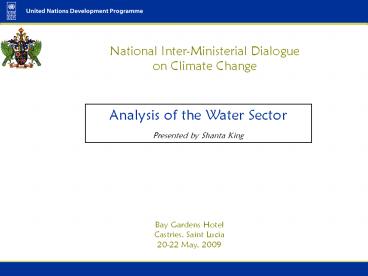National Inter-Ministerial Dialogue PowerPoint PPT Presentation
1 / 10
Title: National Inter-Ministerial Dialogue
1
National Inter-Ministerial Dialogue on Climate
Change
Analysis of the Water Sector Presented by
Shanta King
Bay Gardens Hotel Castries, Saint Lucia 20-22
May, 2009
2
Relevance of Water Sector
- Water is Life! Freshwater is a fragile, finite
and vulnerable resource vital to human, economic
and environmental sustainability and influences
national prosperity and quality of life. Catalyst
for Economic Development. - Water demand continues to change rapidly -
extreme north due to high infra structural
development and migration of people into areas in
the north and other major centers of commercial
activity in the south. - Water supply versus demand deficit island wide
affected directly by rainfall distribution. - Potable water supply has been severely affected
by pressures of increased demand as a result of
socio -economic development, destruction of upper
watersheds, increasing exploitation of the rivers
and wetlands, and an inefficient, inadequate and
aging water distribution network. - The ability of WASCO to meet the current demand
for water, island wide is as a result of a
combination of marginal river base flows
experienced during the dry season and high
turbidity during the rainy season.
3
Relevance of Water Sector
- Climate Change Impacts on the Sector
- Changes in surface and groundwater systems
- Changes in water quality
- Increased flooding
- Increased droughts
- Changes in water temperature
- Changes in water chemistry
- Increased water erosion and sedimentation
- Decreased freshwater availability due to
saltwater intrusion - Anthropogenic activities currently affecting the
quality of rivers freshwater systems. These
include housing, agriculture, water abstraction,
sewage disposal, solid waste disposal, tourism,
fishing, river sand mining, manufacturing, river
bathing and picnicking, and river alteration.
4
Description of the Water Sector
- Saint Lucia experiences a tropical marine climate
with 2 seasons Wet (June-November), Dry
(December-May). - Water demand continues to change rapidly -
extreme north due to high infra structural
development and migration of people into areas in
the north and other major centers of commercial
activity in the south. - Water resources from surface sources in rivers,
wetlands, streams and springs. 37 main sources of
surface run-off few groundwater sources.
Integrated network of river intakes, treatment
plants, transmission pipelines and distribution
systems. - Four (4) major water supply systems in the
country North - Roseau Dam and Hill 20, South -
Grace and Beausejour. Supply to the treatment
plants through both gravity and pumped conveyance
systems which treat the raw water in filtration
plants and then disinfect. - Approx. 56,000 customers (residential
commercial)
5
Description of the Water Sector
IMPACTS
Climate Change Factor Sea Level Rise
Sea level rise may precipitate the intrusion of salt water into fresh water lenses, particularly in low- lying coastal areas.
Climate Change Factor Tropical Storm Activity
Destruction and/or modification of existing aquatic ecosystems caused by the increased frequency and intensity of precipitation. Soil erosion resulting from increased surface run off on exposed soils. Siltation of river systems during periods of increased rainfall.
6
Description of the Water Sector
IMPACTS
Climate Change Factor Precipitation
Decreased precipitation
Periods of low precipitation are likely to be accompanied by extended dry periods. Increased frequency Intensity of precipitation
Destruction and/or modification of existing aquatic ecosystems. Siltation of river systems. Increased incidence of flooding. The likelihood of cross contamination from leaching of pit latrines into flood plains increases during flooding.
Climate Change Factor Temperature
Possibility of excessive evapo-transpiration associated with the level of temperature increases of the high precipitation scenario. Municipal demands are likely to increase as higher temperatures lead to increased water consumption.
7
Proposed Adaptation Options
- Reductions in line losses and improvement of
water supply infrastructure. - Restoration of riverbanks and wetlands
- Water conservation (Rainwater harvesting,
wastewater - re-use, desalination)
- Public awareness
- Improved management of forest resources
including private forests - Strengthen and sustain data collection systems
- Development of a national water management plan
8
Proposed Adaptation Options
- GOSL Climate Change Policy and Adaptation
Plan (2003) - Develop basis for sound decision making by
developing of capacity to undertake research into
relevant climate change processes. - Undertake a comprehensive inventory of all water
resources including surface and ground water. - Promote strengthening of national water
management agencies to ensure the sound
management of the islands water resources. - Develop a long-term national water management
plan which addresses Climate Change concerns
including catchment watershed protection
saltwater intrusion. - Undertake reforestation other measures to
increase the resilience of watersheds and
catchments to maximize water availability to
reduce soil erosion and sedimentation. - Assess address needs for water storage
distribution infrastructure to ensure water
availability during drought periods. - Promote initiatives to identify exploit
non-traditional water sources such as groundwater.
9
Recommendations for conducting assessment of IFF
- Proposed approach to assess investment and
financial flows - Development and application of appropriate models
to clearly articulate anticipated climate change
scenarios and the effects on the sector. Use of
the PRECIS model and a compatible global model.
(SNC) - Situation analysis using a basic scenario with or
without climate change. - Assessment of costs anticipated with the existing
challenges without the application of climate
change scenarios. - Assessment of costs associated with climate
change. (Other Costs EC1.7 billion for 30yrs,
US61.4 million short to medium term) - Comparison of implementation timeline of normal
development objectives in the sector.
Determination of extent to which climate change
impacts would have an effect in advance of the
normal development commitments. - Establishment of a system for allocating
investments and financial flows to climate change
adaptation. (SNC)
10
- Thank You
- for your attention

